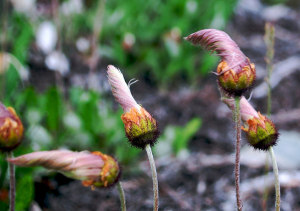I spied a few arnicas in bloom on last night’s dog walk, so it’s time to repost another of the wildflower posts.
From a web search for information on this wildflower, it’s easy to see that it is best known for its use in herbal medicine. It is one of those “external use only” plants, rubbed on the skin in hopes of soothing all manner of owies—scrapes, bruises, sprains, muscle pain, chapped lips, irritated nostrils, acne, burns, sores, and eczema. What’s more, applied to the scalp, arnica makes hair grow, so look out, Rogaine! It has the potential, however, to be a cure that is worse than the disease. With a warning lable that says, “May produce severe inflammation,” you may want to think twice before using it, especially for your irritated nostrils.
 On the right is another yellow wildflower. I know it doesn’t look yellow in the photo, but those pods in the photo were flowers just a little while ago. They looked like this, and that’s why it’s called the yellow dryas. I don’t know what you think, but I like them better as a little hairy fruit than in yellow flower form.
On the right is another yellow wildflower. I know it doesn’t look yellow in the photo, but those pods in the photo were flowers just a little while ago. They looked like this, and that’s why it’s called the yellow dryas. I don’t know what you think, but I like them better as a little hairy fruit than in yellow flower form.It’s when they’re dressed in their light lavender silky threads and golden crowns that the name dryas seems most appropriate. Dryas, as you know if you’re up on Greek mythology, was the son of King Lycurgus. A right royal myth prince was he. Unfortunately for prince Dryas, one day his father went a tad loony and mistook his own royal offspring for a patch of ivy and killed him. It’s in this young prince’s memory that someone named these little whippersnappers dryas. I suppose that’s because it would be next to impossible to mistake them for ivy unless you were loony.
Previous wildflower posts: